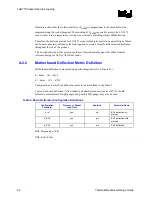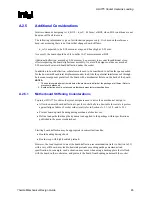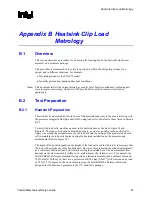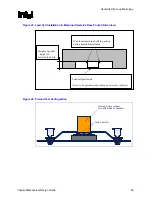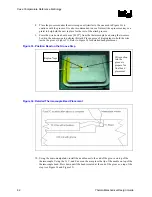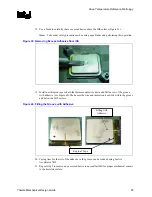
Heatsink Clip Load Metrology
R
70
Thermal/Mechanical Design Guide
B.2.2
Typical Test Equipment
For the heatsink clip load measurement, use equivalent test equipment to that listed in Table 6.
Table 6. Typical Test Equipment
Item
Description
Part Number (Model)
Load cell
Notes: 1, 5
Honeywell-Sensotec* Model 13 subminiature load cells,
compression only
Select a load range depending on load level being tested.
AL322BL
Data Logger (or
scanner)
Notes: 2, 3, 4
Vishay Measurements Group Model 6100 scanner with a
6010A strain card (one card required per channel).
Model 6100
NOTES:
1.
Select load range depending on expected load level. It is usually better, whenever possible, to
operate in the high end of the load cell capability. Check with your load cell vendor for further
information.
2.
Since the load cells are calibrated in terms of mV/V, a data logger or scanner is required to supply 5
volts DC excitation and read the mV response. An automated model will take the sensitivity
calibration of the load cells and convert the mV output into pounds.
3.
With the test equipment listed above, it is possible to automate data recording and control with a
6101-PCI card (GPIB) added to the scanner, allowing it to be connected to a PC running LabVIEW*
or Vishay's StrainSmart* software.
4.
IMPORTANT
: In addition to just a zeroing of the force reading at no applied load, it is important to
calibrate the load cells against known loads. Load cells tend to drift. Contact your load cell vendor for
calibration tools and procedure information.
5.
When measuring loads under thermal stress (bake for example), load cell thermal capability must be
checked, and the test setup must integrate any hardware used along with the load cell. For example,
the Model 13 load cells are temperature compensated up to 71 °C, as long as the compensation
package (spliced into the load cell's wiring) is also placed in the temperature chamber. The load cells
can handle up to 121 °C (operating), but their uncertainty increases according to 0.02% rdg/°F.
B.3
Test Procedure Examples
The following sections give two examples of load measurement. However, this is not meant to be
used in mechanical shock and vibration testing.
Any mechanical device used along with the heatsink attach mechanism will need to be included in
the test setup (i.e., back plate, attach to chassis, etc.).
Prior to any test, make sure that the load cell has been calibrated against known loads, following
load cell vendor’s instructions.
Summary of Contents for 640 - Pentium 4 640 3.2GHz 800MHz 2MB Socket 775 CPU
Page 14: ...Introduction R 14 Thermal Mechanical Design Guide ...
Page 38: ...Thermal Management Logic and Thermal Monitor Feature R 38 Thermal Mechanical Design Guide ...
Page 52: ...Intel Thermal Mechanical Reference Design Information R 52 Thermal Mechanical Design Guide ...
Page 60: ...Acoustic Fan Speed Control R 60 Thermal Mechanical Design Guide ...
Page 72: ...Heatsink Clip Load Metrology R 72 Thermal Mechanical Design Guide ...
Page 99: ...Mechanical Drawings R Thermal Mechanical Design Guide 99 Figure 50 Reference Fastener Sheet 1 ...
Page 103: ...Mechanical Drawings R Thermal Mechanical Design Guide 103 Figure 54 Clip Heatsink Assembly ...







